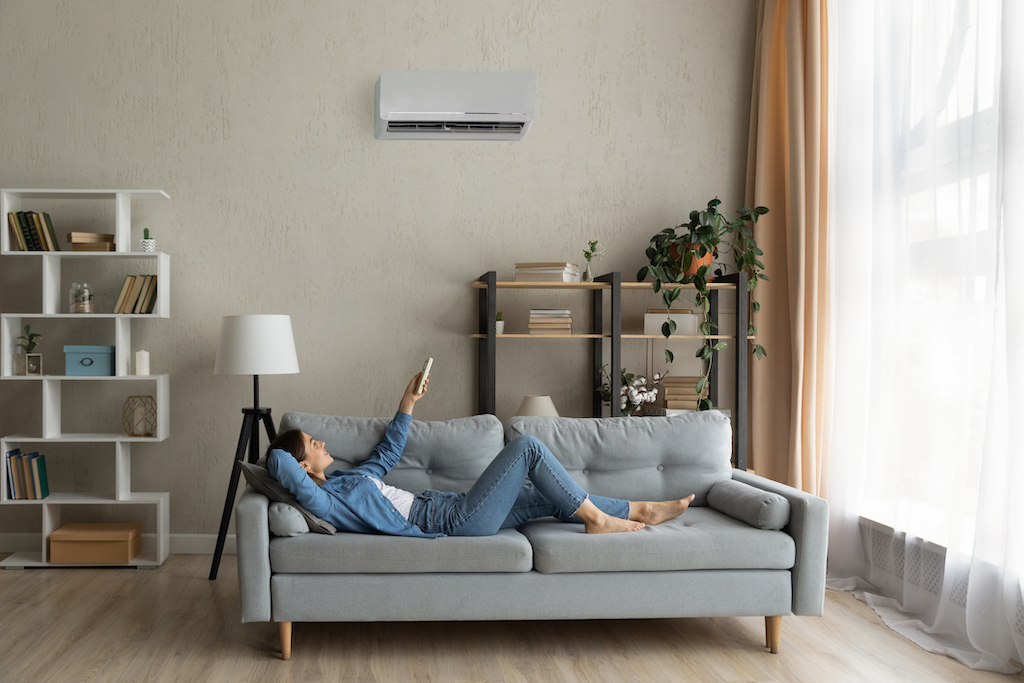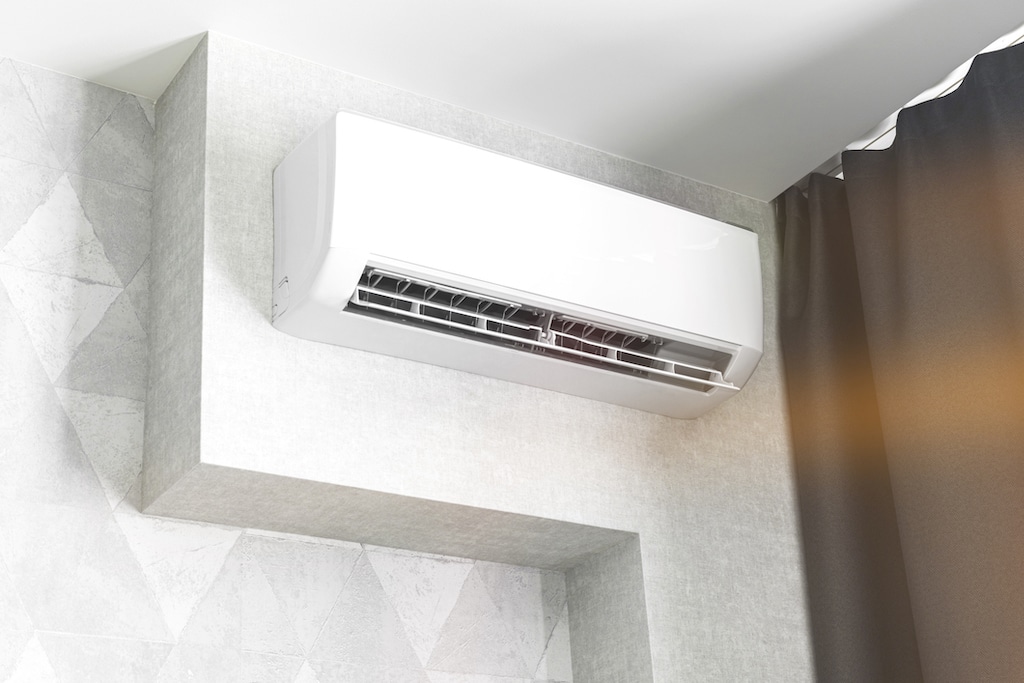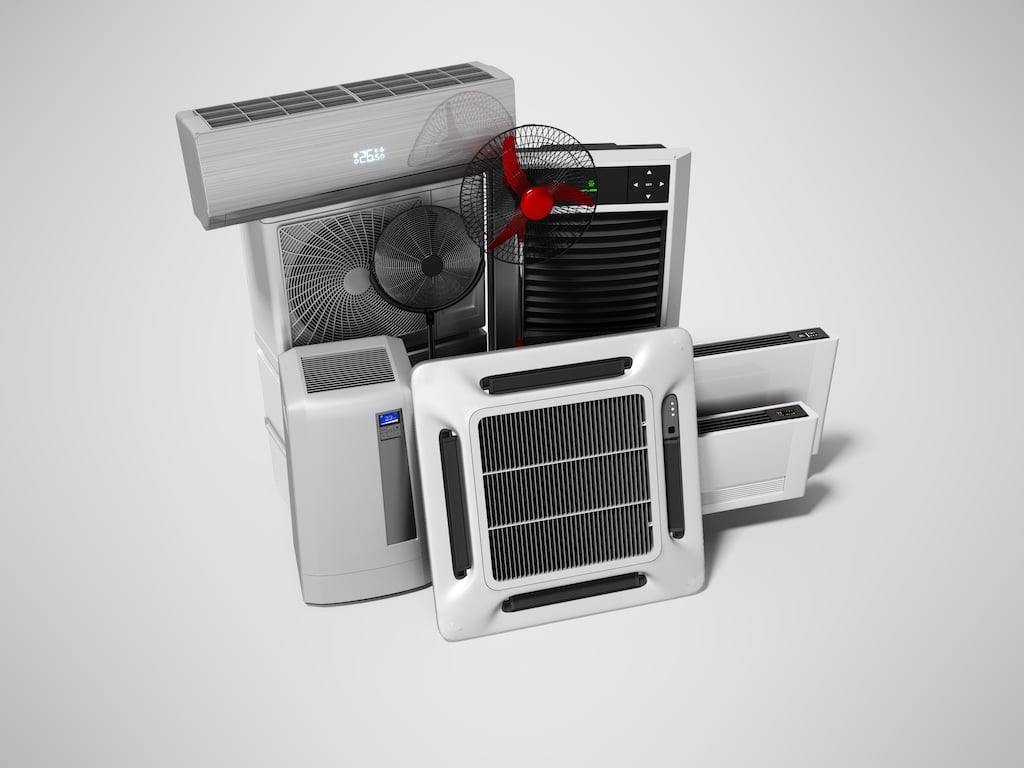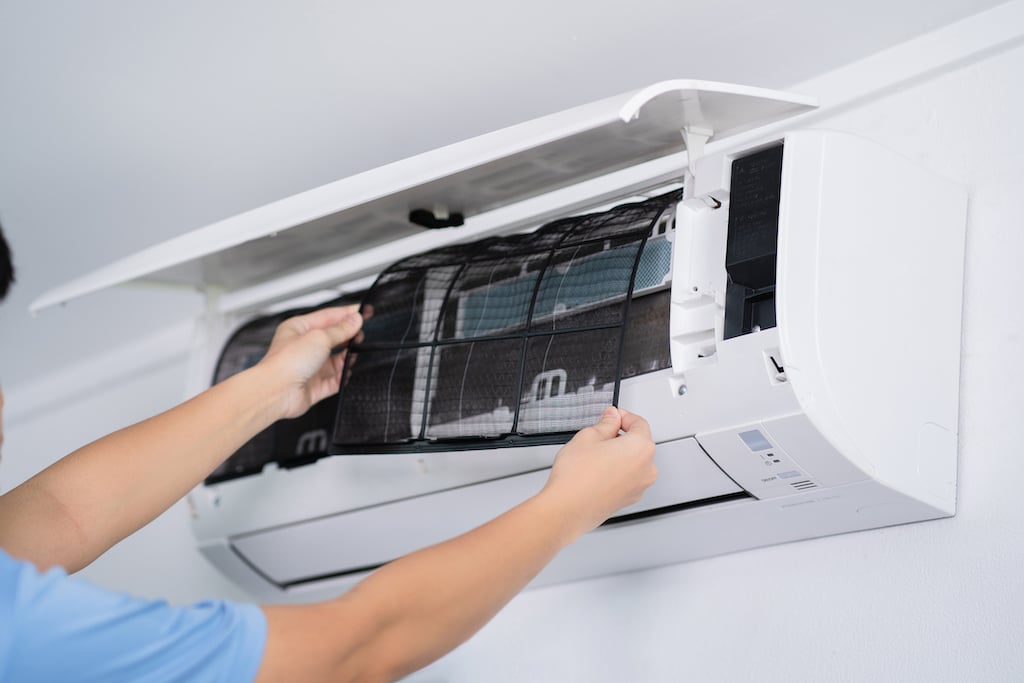
Effortless Comfort: Installing Ductless Mini Split AC
Have you ever considered the transformative impact of installing a ductless mini split AC in your home?
Imagine a summer without the sweltering heat or a winter where you can lounge in cozy warmth. This isn’t just about adding an appliance; it’s about upgrading your living space for unparalleled comfort.
In this article, we delve deep into the world of ductless mini split AC systems. From understanding the basics to exploring the benefits, we’ve got you covered.
You’ll learn how to choose the right system for your home, installing ductless mini split AC process, and tips to maintain your unit for years of efficient operation.
Whether you’re a DIY enthusiast or planning to hire professionals, this guide is your one-stop resource for all things related to ductless mini split AC.

Photo By Vlad Yushinov at iStock
What is a Ductless Mini Split AC?
Installing ductless mini split AC is a transformative process for any homeowner seeking a modern, efficient way to manage their indoor climate.
This system consists of two main components: an outdoor compressor/condenser and one or more indoor air-handling units. These components are connected by a conduit, which houses the power cable, refrigerant tubing, suction tubing, and a condensate drain, eliminating the need for bulky ductwork.
This setup allows for a flexible, scalable approach to heating and cooling different areas of your home.
Each indoor unit can be controlled independently, providing personalized comfort zones across various rooms. This is particularly advantageous in homes where extending or installing new ductwork is impractical or too costly.
Moreover, the ductless mini split AC system stands out for its energy efficiency.
Unlike traditional HVAC systems, which can lose energy through ductwork leaks and inefficiencies, ductless mini splits deliver temperature-controlled air directly into each room.
This direct approach significantly reduces energy loss, leading to lower utility bills and a smaller carbon footprint.
For homeowners contemplating installing ductless mini split AC, it represents not just an upgrade to their heating and cooling capabilities but also a smart investment in their property’s value and their quality of life.
This system offers an elegant solution to the challenges of maintaining a comfortable, energy-efficient home environment.
Also read: Busting Common Hvac Energy Efficiency Myths With Your Ac Repair Company
Benefits of Ductless Mini Split Systems
Enhanced Energy Efficiency
When it comes to installing ductless mini split AC systems, one of the most significant advantages is their energy efficiency. Traditional HVAC systems often lose a substantial amount of energy due to heat exchange in the ductwork.
In contrast, ductless mini split systems deliver air directly into different zones, significantly reducing energy loss. This direct approach to heating and cooling not only makes these systems more efficient but also leads to lower utility bills for homeowners.
The efficiency of ductless mini split systems is further enhanced by their inverter technology, which allows the compressor to speed up or slow down based on the needs of the indoor environment, rather than turning off and on entirely.
This modulation means the system uses only the amount of energy necessary to maintain the desired temperature, avoiding the energy spikes associated with traditional systems cycling on and off.
For homeowners considering installing ductless mini split AC, this translates to long-term savings and a reduced environmental footprint.
Customizable Comfort with Zoning
Another key benefit of installing ductless mini split AC systems is the ability to create zones within your home, each with individual temperature controls. This zoning capability means you can customize the heating and cooling for different areas, ensuring optimal comfort throughout your space.
Whether you have a home office that needs to be cooler than the rest of the house or a seldom-used guest room that doesn’t need constant heating or cooling, ductless systems offer the flexibility to meet these needs.
Zoning also contributes to the system’s efficiency.
By only heating or cooling the areas in use, you avoid wasting energy on empty rooms. This not only makes your home more environmentally friendly but also allows for more precise comfort management.
For those installing ductless mini split AC systems, the impact is a more comfortable living environment tailored to the specific preferences of each household member.
Minimal Installation Impact
The process of installing ductless mini split AC systems is notably less invasive than that of traditional HVAC systems.
Because there’s no need for ductwork, the installation can often be completed in a single day, depending on the complexity and number of indoor and outdoor units being installed. This minimal impact is a significant advantage for homeowners, especially those in older homes where installing ductwork would be impractical or too disruptive.
Ductless systems require just a small hole in the wall for the conduit that connects the indoor and outdoor units, reducing the risk of air leakage and security concerns associated with larger openings.
This aspect of ductless system installation appeals to homeowners looking for a quick, efficient solution to their heating and cooling needs, without the mess and stress of extensive renovations.
Long-Term Reliability and Lower Maintenance
Ductless mini split systems are renowned for their durability and long-term reliability. With fewer moving parts than traditional HVAC systems and no ductwork to maintain, they often experience fewer issues over their lifespan.
Maintenance is typically straightforward, involving regular cleaning of the filters and an annual check-up, which can be easily managed by homeowners or through a professional service.
This reliability is a crucial consideration for those installing ductless mini split AC systems, as it means fewer repairs and a longer lifespan for their investment.
The reduced need for maintenance not only saves time and money but also ensures that the system continues to operate efficiently year after year, providing consistent comfort without the hassle.
Improved Air Quality
Finally, installing ductless mini split AC systems can lead to improved indoor air quality. Traditional HVAC systems can circulate dust, pollen, and other allergens throughout the home via ductwork.
In contrast, ductless systems have multi-stage filtration that reduces dust, bacteria, pollen, allergens, and other particulates in the air. For families with allergies or respiratory issues, this can make a significant difference in the comfort and healthiness of their living environment.
The air quality benefit is an important factor to consider when choosing a heating and cooling solution.
For those installing ductless mini split AC systems, the peace of mind that comes with cleaner air is an invaluable addition to the comfort and efficiency these systems provide.

Photo By Marianna Lishchenco at iStock
How to Choose the Right AC System
Assessing Your Space
When it comes to installing ductless mini split AC, the first step is assessing the size of the space you need to cool or heat. This is not just about square footage; ceiling height, window size, insulation quality, and even the room’s orientation relative to the sun play significant roles in determining the capacity required for your ductless mini split system.
An undersized unit will run continuously, struggling to reach the desired temperature, while an oversized unit can lead to inefficient cycling, humidity issues, and uneven temperature distribution.
Professional HVAC contractors use detailed calculations, often referred to as Manual J calculations, to determine the precise heating and cooling load of your space. These calculations take into account all relevant factors, ensuring that the system chosen is perfectly tailored to your home’s unique requirements.
For homeowners installing ductless mini split AC systems, this step is crucial for achieving optimal comfort and efficiency.
Understanding Your Climate
The climate in your area significantly influences the type of ductless mini split AC system you should choose.
In regions with extreme temperatures, whether hot or cold, the system’s ability to operate efficiently under such conditions is paramount. Some systems are specifically designed to perform in colder climates, offering enhanced heating capabilities without compromising efficiency.
For those living in areas with mild climates, a standard ductless mini split system might suffice. However, in regions where temperatures frequently drop below freezing, looking into models with a built-in base pan heater or those rated for lower outdoor temperatures becomes essential.
Consulting with a professional who understands the nuances of installing ductless mini split AC systems in various climates can help you select a unit that will provide reliable comfort year-round.
Tailoring to Your Comfort Needs
Every household’s comfort needs are unique, influenced by personal preferences, lifestyle, and even health considerations.
When selecting a ductless mini split AC system, consider how you use your space.
Do you need different temperatures in various rooms?
Are there areas of your home that are used infrequently?
Ductless systems offer the flexibility of zoning, allowing you to customize temperature settings for individual rooms or areas.
Additionally, features such as programmable thermostats, remote controls, and smart home compatibility can enhance convenience and efficiency. For those particularly sensitive to noise, selecting a system known for its quiet operation is also a key consideration.
Discussing your specific comfort needs with a professional before installing ductless mini split AC ensures that the system you choose enhances your living environment in every aspect.
Consulting with a Professional
Perhaps the most critical step in choosing the right ductless mini split AC system is consulting with a professional.
HVAC professionals bring a wealth of experience and knowledge, not only about the systems themselves but also about their installation and maintenance. They can provide valuable insights into the best brands, models, and configurations for your specific needs and circumstances.
A professional installer can also identify potential challenges or unique installation requirements for your home, ensuring that the process goes smoothly.
From the initial assessment to the final installation and testing, their expertise is invaluable in guaranteeing that your ductless mini split system is correctly sized, efficiently installed, and ready to provide years of comfortable, trouble-free service.
Finalizing Your Decision
After considering the size of your space, the local climate, your personal comfort needs, and consulting with a professional, you’re ready to make an informed decision about which ductless mini split AC system to install. This process ensures that your investment not only adds value to your home but also provides a level of comfort and efficiency tailored to your lifestyle.
Remember, the right system will offer a balance of performance, energy efficiency, and user-friendly features, making installing ductless mini split AC a smart choice for modern living.
Installing Ductless Mini Split AC Process
Site Selection for Optimal Performance
The initial step in installing ductless mini split AC systems is the meticulous selection of the site for both the indoor and outdoor units. This decision is paramount for the system’s efficiency and overall performance.
The location of the indoor unit should be in a central area of the room to ensure even distribution of air. Factors such as direct sunlight, obstructions, and room layout must be considered to avoid hot or cold spots within the space.
The goal is to provide uniform comfort throughout the room, which requires strategic placement that only a professional can accurately determine.
For the outdoor unit, the chosen site must offer a balance of exposure and protection. While it’s crucial to have the unit in a place that’s free from obstructions to maintain airflow, it’s equally important to protect it from extreme weather conditions that could impact its efficiency and lifespan.
Mounting the Indoor Unit with Precision
Mounting the indoor unit is a step that requires precision and attention to detail during the installing ductless mini split AC process.
The unit must be securely attached to a wall or ceiling, depending on the model and the specific requirements of the space.
Ensuring the unit is level is critical, as an improperly mounted unit can lead to issues with condensation drainage and may affect the efficiency of air distribution.
The height at which the unit is installed also plays a crucial role in its performance. Typically, it is recommended to mount the unit at least six feet above the floor to optimize air distribution and ensure efficient heating and cooling.
This height allows the unit to disperse air over a wide area, promoting even temperatures throughout the room.
Professionals use specialized tools and techniques to ensure the unit is mounted securely and at the optimal height, taking into account the room’s layout and the occupants’ comfort.
Installing the Outdoor Unit for Maximum Efficiency
The installation of the outdoor unit is a critical phase in installing ductless mini split AC systems, as it houses the compressor and plays a vital role in the system’s overall efficiency.
The unit must be placed on a stable, level surface to operate correctly. An uneven surface can cause vibration, leading to noise issues and potential damage to the unit over time.
Installing ductless mini split ac professionals often use a concrete pad or anti-vibration mounts to ensure stability and reduce noise.
The location of the outdoor unit must also allow for adequate airflow around all sides. This is crucial for the heat exchange process, as restricted airflow can cause the unit to overheat, reducing efficiency and potentially leading to system failure.
The unit should be positioned away from any structures or vegetation that could obstruct airflow, with a clear space of at least 24 inches on all sides. This strategic placement ensures the unit can draw in and expel air effectively, maintaining optimal performance and efficiency.
Here’s everything else you need to know about maintaining and installing ductless mini split ac, ensuring it provides efficient comfort for years to come.
The Environmental Impact of Ductless Mini Split AC
Reducing Carbon Footprint
The decision to proceed with installing ductless mini split AC systems in homes or businesses is not only a step towards enhanced comfort but also a stride towards environmental conservation.
Traditional HVAC systems, especially older models, are often inefficient and consume a significant amount of electricity, much of which is generated from fossil fuels. This high energy consumption directly contributes to a larger carbon footprint, given the greenhouse gasses emitted during the production of electricity.
In contrast, ductless mini split AC systems are designed with the latest inverter technology, allowing them to adjust their output based on the actual demand in the room.
This means they consume only the energy needed to maintain the desired temperature, significantly reducing electricity usage.
By installing ductless mini split AC units, homeowners can significantly lower their carbon emissions associated with heating and cooling their homes. This reduction in energy consumption is crucial in the global effort to combat climate change, making ductless systems an environmentally responsible choice for temperature regulation.
Promoting Sustainable Energy Use
Installing ductless mini split AC systems aligns with the broader movement towards sustainable energy use in residential and commercial properties.
These systems are highly efficient, converting a greater portion of their energy input into useful heating or cooling output, with minimal waste compared to traditional systems. This efficiency is particularly beneficial in areas where electricity is generated from renewable sources, such as solar or wind power, further enhancing the environmental benefits of choosing a ductless system.
Moreover, the zoning capabilities of ductless mini split systems allow for targeted heating and cooling. This means that energy is not wasted on unoccupied rooms, promoting a more sustainable use of resources.
Homeowners who opt for installing ductless mini split AC systems can take pride in their proactive approach to energy conservation, contributing to a reduction in the overall demand for fossil fuels and helping to mitigate the effects of global warming.
Minimizing Refrigerant Impact
The environmental impact of installing ductless mini split AC systems also extends to the type of refrigerants used.
Modern ductless systems utilize refrigerants with a lower global warming potential (GWP) and ozone depletion potential (ODP) than those used in older HVAC systems. This shift towards more eco-friendly refrigerants is crucial in reducing the harmful effects that these substances can have on the atmosphere.
Manufacturers of ductless mini split systems are continuously innovating to develop and use refrigerants that are not only efficient in heat transfer but also have minimal environmental impact.
By installing ductless mini split AC, homeowners are supporting the transition to safer refrigerant technologies, further contributing to the protection of the ozone layer and the reduction of greenhouse gas emissions.
Enhancing Indoor Air Quality
Beyond the direct environmental benefits associated with reduced energy consumption and the use of eco-friendly refrigerants, installing ductless mini split AC systems also contributes to improved indoor air quality.
Traditional ducted systems can circulate dust, allergens, and other pollutants throughout a home, whereas ductless systems offer multi-stage filtration to reduce these airborne contaminants.
Improved indoor air quality has a positive impact on the health of the home’s occupants, reducing the risk of respiratory problems, allergies, and other health issues.
This aspect of ductless systems underscores the holistic environmental benefits they offer, contributing not only to the external environment but also to the creation of healthier living spaces.
Zoning Capabilities Explained
Personalized Comfort Through Zoning
The concept of zoning in the context of installing ductless mini split AC systems is transformative, offering a level of personalized comfort previously unattainable with traditional HVAC systems.
Zoning allows homeowners to divide their living space into distinct areas or “zones,” each with its own temperature control. This means that different rooms can be set to different temperatures simultaneously, catering to the individual preferences of occupants and the specific requirements of each space.
For instance, during the night, bedrooms might need to be cooler than the rest of the house for comfortable sleep, while during the day, living areas might require a different temperature for optimal comfort.
By installing ductless mini split AC systems with zoning capabilities, homeowners can easily adjust temperatures in various parts of their home without affecting the comfort of other areas.
This level of control not only enhances comfort but also significantly improves energy efficiency, as energy is not wasted on cooling or heating unoccupied spaces.
Energy Efficiency and Cost Savings
One of the most compelling reasons for installing ductless mini split AC systems with zoning capabilities is the potential for energy savings.
By allowing homeowners to heat or cool only the areas that are in use, ductless systems with zoning capabilities can significantly reduce overall energy consumption. This targeted approach to temperature control means that you’re not spending money to maintain the comfort of empty rooms, leading to noticeable reductions in monthly energy bills.
The efficiency of zoning is further enhanced by the advanced technology of ductless mini split systems, which can precisely control the temperature of each zone without the energy losses associated with ductwork.
This precise control and reduced energy consumption make installing ductless mini split AC systems an economically smart choice for homeowners looking to optimize their home’s energy use and save money in the long term.
Enhancing System Longevity and Performance
The zoning capabilities of ductless mini split systems also contribute to the longevity and performance of the equipment.
By reducing the overall load on the system—since it’s not required to heat or cool the entire home to a single temperature—wear and tear on the components are minimized.
This can extend the life of the system, reducing the need for repairs and prolonging the periods between necessary maintenance.
Furthermore, because each zone can be controlled independently, issues within one zone (such as a temporary increase in heat load due to cooking or a large number of guests) can be managed without impacting the comfort of other areas. This adaptability not only ensures consistent comfort across all zones but also prevents the system from being overtaxed, maintaining its efficiency and performance over time.
Installation Flexibility and Future Expansion
The modular nature of installing ductless mini split AC systems offers unparalleled flexibility in installation and the potential for future expansion.
Homeowners can start with a single outdoor unit connected to one or more indoor units, depending on their immediate needs, and expand the system later by adding more indoor units as required.
This flexibility is particularly advantageous for those undergoing gradual home renovations or extensions, as it allows for the phased implementation of climate control solutions without the need for a complete system overhaul.
Additionally, the ability to add zones over time means that homeowners can tailor their system to changing lifestyle needs.
Whether accommodating a new home office, a gym, or ensuring guests have a comfortable stay, the zoning capabilities of ductless systems provide a scalable solution that traditional HVAC systems simply cannot match.

Photo By Phira Phonruewiangphing at iStock
Maintenance Tips for Peak Performance
Regular Cleaning of Filters
One of the most crucial maintenance tasks for ensuring the peak performance of your ductless mini split AC system involves the regular cleaning of air filters.
When you embark on installing ductless mini split AC units, it’s essential to understand that clean filters are vital for maintaining air quality and ensuring efficient system operation.
Over time, filters can accumulate dust, pet dander, and other airborne particles, which can impede airflow and reduce the system’s efficiency.
By routinely cleaning or replacing the filters (depending on the model), you can prevent these issues.
Most ductless mini split systems feature easily accessible filters that homeowners can clean with mild soap and water.
This simple maintenance task, performed every month or as recommended by the manufacturer, can significantly impact the system’s effectiveness, reducing energy consumption and preventing overwork that could lead to premature wear and tear.
Ensuring Proper Outdoor Unit Placement and Clearance
After installing ductless mini split AC systems, it’s crucial to periodically check the outdoor unit’s placement and ensure it maintains proper clearance.
The outdoor unit should be situated in a location where it’s free from debris, such as leaves, dirt, and snow, which can obstruct airflow and reduce the system’s efficiency. Additionally, make sure that the unit is on a stable and level surface to prevent vibration, which can not only cause noise but also potentially damage the unit over time.
Homeowners should maintain at least a two-foot clearance around the outdoor unit to facilitate adequate airflow and easy access for maintenance or repairs.
This includes trimming any shrubs or plants that could grow too close to the unit and removing any objects that might obstruct airflow. Regular inspection and clearance of the area around the outdoor unit can prevent airflow blockages, ensuring that your system operates at peak efficiency.
Scheduling Professional Maintenance Checks
While many aspects of ductless mini split AC maintenance can be handled by homeowners, scheduling professional maintenance checks is essential for long-term performance and efficiency.
An experienced technician can perform a comprehensive evaluation of the system, including checking refrigerant levels, inspecting electrical connections, and ensuring that all components are functioning correctly.
Professional maintenance typically includes tasks that are beyond the scope of routine homeowner maintenance, such as cleaning the coils and flushing the condensate line to prevent blockages.
These checks, recommended at least once a year, can identify potential issues before they become major problems, saving you money on repairs and extending the life of your system.
Investing in a professional maintenance plan after installing ductless mini split AC systems can provide peace of mind and ensure that your system operates efficiently year-round.
Monitoring System Performance and Addressing Issues Promptly
After installing ductless mini split AC systems, it’s important for homeowners to stay vigilant and monitor their system’s performance.
Be attentive to changes in cooling or heating efficiency, unusual noises, or any signs of leakage around the indoor or outdoor units. These could indicate potential issues that need immediate attention.
Addressing problems promptly can prevent minor issues from escalating into major repairs or system failures.
For example, a decrease in cooling efficiency could be due to a refrigerant leak, while strange noises might indicate a problem with the fan or compressor.
By keeping an eye on the system’s performance and acting quickly when something seems amiss, homeowners can ensure their ductless mini split AC continues to operate at peak efficiency.
Troubleshooting Common Issues When Installing Ductless Mini Split Ac
Addressing Reduced Cooling or Heating Efficiency
One of the most frequent concerns after installing ductless mini split AC systems is a noticeable reduction in cooling or heating efficiency. This issue can stem from several sources, such as dirty air filters, blocked air flow, or low refrigerant levels.
The first step in troubleshooting this problem is to check and clean the air filters, as a clogged filter can significantly impede the system’s ability to circulate air efficiently.
Next, ensure that there’s nothing obstructing the indoor and outdoor units’ air flow. Furniture, curtains, or outdoor debris can block the units, reducing efficiency.
If these steps don’t resolve the issue, it could indicate a refrigerant leak or a problem with the system’s compressor, both of which require professional attention.
Regular maintenance checks can often prevent these issues by ensuring that the system operates at peak efficiency and any potential problems are addressed early.
Dealing with Unusual Noises
After installing ductless mini split AC systems, any unusual noises should be promptly investigated.
Sounds like rattling or buzzing can indicate loose components, while whistling or gurgling noises might suggest a refrigerant leak. Initially, inspect the indoor and outdoor units for any visible signs of looseness or damage that could be causing the noise.
Tightening loose components can often resolve rattling noises. However, if the noise persists or if you suspect a refrigerant leak (evidenced by gurgling sounds), it’s crucial to contact a professional.
Refrigerant leaks not only affect system performance but can also pose environmental and health risks. A qualified technician can accurately diagnose and repair the issue, ensuring your system’s safe and efficient operation.
Managing Water Leaks from the Indoor Unit
Water leaking from the indoor unit of your ductless mini split AC can be alarming, but it’s a relatively common issue often related to the condensate drain. This problem can arise from a clogged drain line, improper installation, or issues with the unit’s condensate pump, if equipped.
First, check the condensate drain line for any blockages and clear them if found.
If the system was recently installed, verify that the indoor unit is level; an improperly leveled unit can cause water to drain incorrectly, leading to leaks. If your system includes a condensate pump, ensure it’s functioning correctly, as a malfunction can also lead to water leakage.
If these steps don’t resolve the issue, professional assistance may be required to correct the installation or repair the pump.
Resolving Remote Control Malfunctions
Remote control issues are another common problem encountered by homeowners with ductless mini split AC systems. If the remote control is not working, first check the batteries and replace them if necessary.
If the remote still doesn’t work with fresh batteries, ensure there’s no obstruction between the remote and the indoor unit that could be blocking the signal.
Sometimes, the issue may be with the sensor on the indoor unit rather than the remote itself.
Cleaning the sensor on the indoor unit can help ensure it properly receives signals from the remote. If these steps do not resolve the issue, the remote control may need to be replaced or there could be a more significant problem with the indoor unit’s electronics, requiring professional service.
In troubleshooting common issues after installing ductless mini split AC systems, homeowners can often resolve simple problems through basic checks and maintenance.
However, for more complex issues, especially those involving refrigerant or electrical components, it’s essential to seek professional assistance to ensure safe and effective repairs.
Essential Guidelines for Installing Ductless Mini Split AC Systems
-
Professional Installation is Key
Expert installation ensures optimal efficiency, longevity, and warranty coverage. Certified HVAC professionals are equipped to handle the complexities of installation, including assessing the space, choosing the right system, and ensuring it meets all operational requirements.
This approach not only guarantees the system’s effectiveness but also safeguards against common installation errors that can compromise efficiency and performance.
-
Choosing the Right System:
Selecting the appropriate AC system is crucial for long-term satisfaction.
Factors such as cooling capacity, energy efficiency, and specific features should guide your decision. The guide suggests considering different types of AC systems, including ductless mini-split systems, to find one that best suits your needs.
This step is vital in ensuring that the system efficiently meets the cooling demands of your space without incurring unnecessary energy costs.
-
Preparation for Installation:
Proper preparation can significantly smooth the installation process.
Assessing your space to determine the best location for the AC unit, ensuring adequate ventilation and airflow, and making any necessary electrical upgrades are essential steps.
A checklist of tools and equipment needed for installation can help avoid delays, ensuring a hassle-free setup.
3. Step-by-Step Installation Process:
A detailed, step-by-step approach to installing your AC system is crucial for a successful setup. From unpacking and preparing the unit to mounting, connecting electrical wiring, and setting up refrigerant lines, each step requires careful attention.
The guide provides instructions and tips for each stage, including post-installation testing, to ensure the system operates optimally.
-
Maintaining Your AC System:
Regular maintenance is key to extending the lifespan of your AC system. The guide outlines essential tasks such as cleaning or replacing air filters, scheduling professional tune-ups, and maintaining proper airflow.
Addressing common issues promptly and ensuring energy efficiency can keep the system running smoothly for years.
These insights offer a comprehensive overview for anyone considering installing ductless mini split AC systems, highlighting the importance of professional installation, proper system selection, and ongoing maintenance for optimal performance and efficiency.
One Hour Air Conditioning & Heating of Fort Worth: Your Trusted Partner in Installing Ductless Mini Split AC
Expertise in Local Climate Solutions
With a deep understanding of the Fort Worth area and its unique climate challenges, One Hour Air Conditioning & Heating offers tailored solutions for your ductless mini split AC needs. Their team of certified professionals ensures a seamless installation and maintenance experience. Check out their reviews on Google Profile.
For homeowners in Fort Worth, TX, and surrounding areas, including Azle, Euless, North Richland Hills, Arlington, Southlake, Keller, and Grapevine, One Hour Air Conditioning & Heating is your go-to source for expert ductless mini split AC installation and service.
Contact us today at 817-283-6911 to enhance your home comfort.

Photo By akinbostanci at iStock
FAQs
- What are the main benefits of installing a ductless mini split AC?
The main benefits include energy efficiency, individual zone control, and ease of installation. These systems provide a flexible solution for homes without existing ductwork, offering both cooling and heating capabilities.
- How do I choose the right ductless mini split AC for my home?
Consider the size of your space, the climate, and specific needs such as the number of zones required. Consulting with a professional can ensure you select a system that meets your home’s demands.
- Can I install a ductless mini split AC system myself?
While DIY installation is possible, it’s recommended to have a professional install your system to ensure optimal efficiency and to maintain the manufacturer’s warranty.
- How long does a ductless mini split AC last?
With proper maintenance, ductless mini split AC systems can last up to 20 years, providing long-term comfort and efficiency.
- What maintenance does a ductless mini split AC require?
Regular maintenance includes cleaning filters, checking the refrigerant level, and ensuring the outdoor unit is free from debris.
Have you considered installing a ductless mini split AC in your home?
What are your main considerations or questions regarding this efficient cooling and heating solution?
Read our previous blog post.
Check out this tip!
Dustin Hufsey


